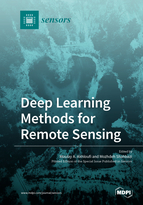Deep Learning Methods for Remote Sensing
A special issue of Sensors (ISSN 1424-8220). This special issue belongs to the section "Remote Sensors".
Deadline for manuscript submissions: closed (31 March 2022) | Viewed by 56482
Special Issue Editors
Interests: machine learning; deep learning; computer vision; robotics; medical imaging
Special Issues, Collections and Topics in MDPI journals
Interests: vision-guided unmanned aerial systems; integration and calibration of ranging and imaging technologies; deep learning
Special Issues, Collections and Topics in MDPI journals
Special Issue Information
Dear Colleagues,
The areas of machine learning and deep learning have experienced impressive progress in recent years. This progress has been mainly driven by the availability of high processing performance at an affordable cost and a large quantity of data. Most state-of-the-art techniques today are based on deep neural networks. This progress has sparked innovations in technologies, algorithms, and approaches and led to results that were unachievable until recently. Among the various research areas that have been significantly impacted by this progress is remote sensing.
This Special Issue aims to gather cutting-edge contributions from researchers using deep learning for remote sensing. Contributions are accepted in different areas of application, including but not limited to environmental studies, precision agriculture, forestry, disaster response, building information modelling, infrastructure inspection, defense and security, benchmarking, and open-access datasets for remote sensing. Studies using active or passive sensors from satellites, airborne platforms, drones, and terrestrial vehicles are welcome.
Contributions can be submitted in various forms, such as research papers, review papers, and comparative analyses.
Prof. Dr. Moulay A. Akhloufi
Dr. Mozhdeh Shahbazi
Guest Editors
Manuscript Submission Information
Manuscripts should be submitted online at www.mdpi.com by registering and logging in to this website. Once you are registered, click here to go to the submission form. Manuscripts can be submitted until the deadline. All submissions that pass pre-check are peer-reviewed. Accepted papers will be published continuously in the journal (as soon as accepted) and will be listed together on the special issue website. Research articles, review articles as well as short communications are invited. For planned papers, a title and short abstract (about 100 words) can be sent to the Editorial Office for announcement on this website.
Submitted manuscripts should not have been published previously, nor be under consideration for publication elsewhere (except conference proceedings papers). All manuscripts are thoroughly refereed through a single-blind peer-review process. A guide for authors and other relevant information for submission of manuscripts is available on the Instructions for Authors page. Sensors is an international peer-reviewed open access semimonthly journal published by MDPI.
Please visit the Instructions for Authors page before submitting a manuscript. The Article Processing Charge (APC) for publication in this open access journal is 2600 CHF (Swiss Francs). Submitted papers should be well formatted and use good English. Authors may use MDPI's English editing service prior to publication or during author revisions.
Keywords
- multispectral, hyperspectral remote sensing
- LiDAR
- UAV
- forest monitoring
- precision agriculture
- environmental monitoring
- natural risks
- defense and security
- machine learning
- deep learning
- data fusion
- sensors
- remote sensing datasets
- image processing
- navigation
- 3-D mapping and modelling
- photogrammetry








